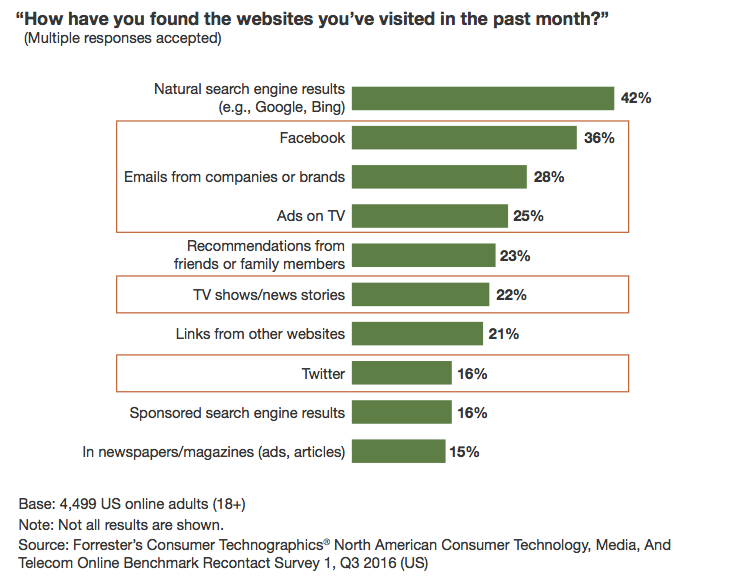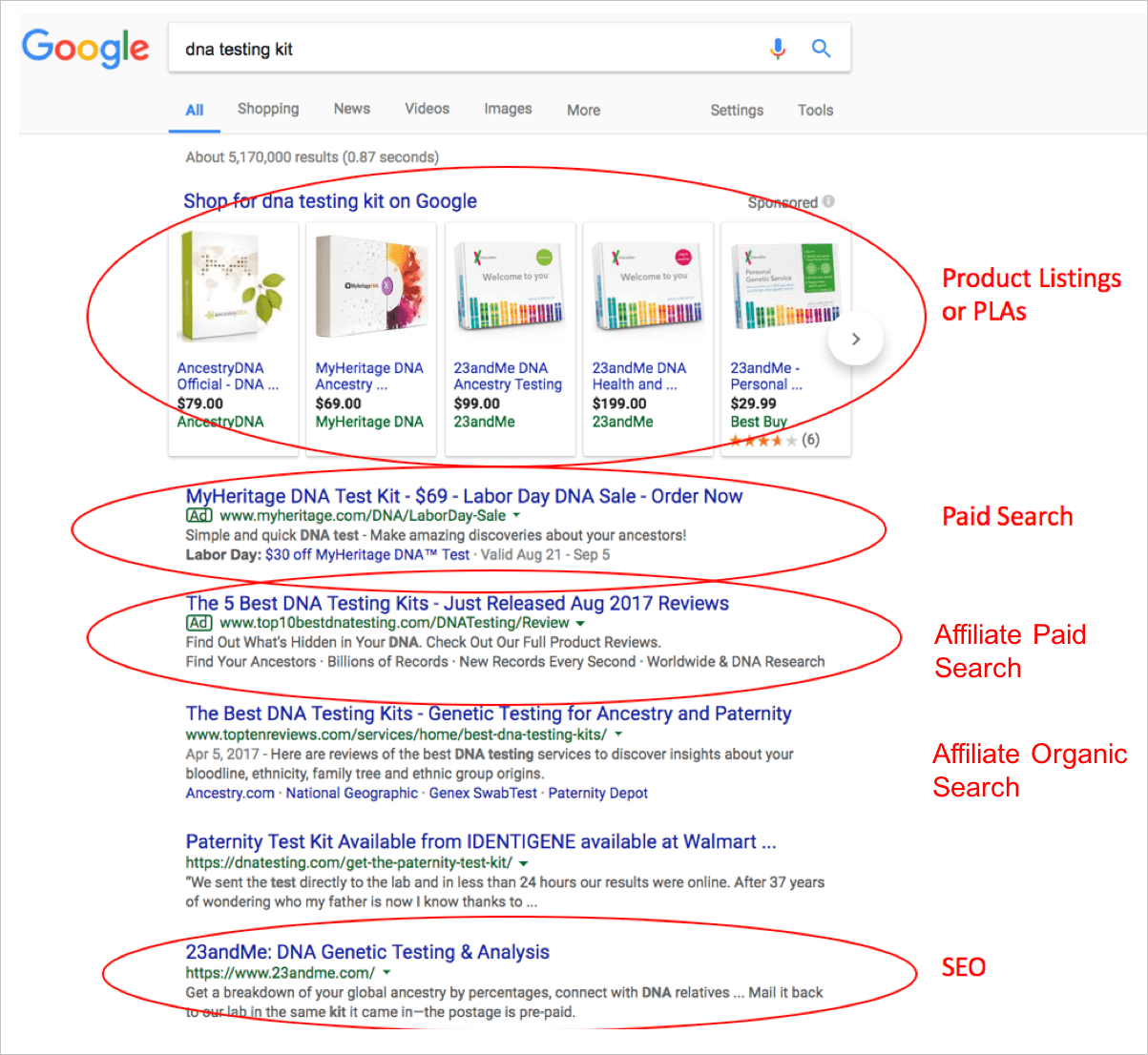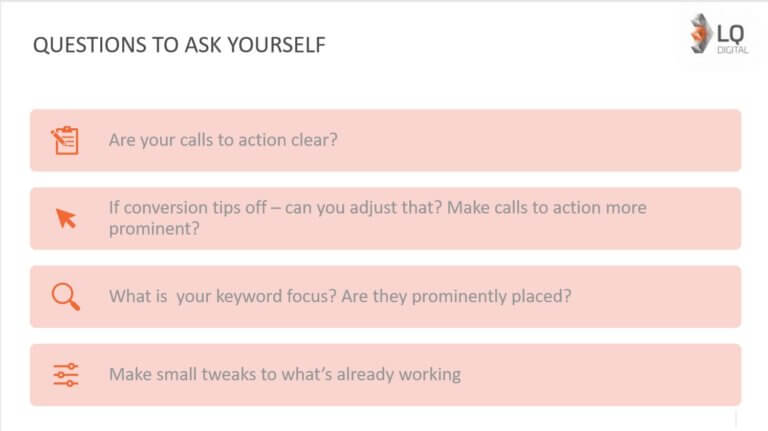Watch the Webinar: SEO long-term planning for recovery
SEO is a key part of any marketing plan and with budgets being cut around paid search and other forms of advertising, now is the perfect time for marketers to review, clean and improve the SEO for their business. Last week, we interviewed our Director of SEO, Jacob King, to identify the low-hanging fruit that marketers could tackle to make an immediate impact on their SEO strategy. Yet, as we all know, SEO isn’t just a short-term play. It can take months to see the true impact of an improved SEO strategy. So this week, we followed up with Jacob to review the tactics and tools that marketers should be using to build a foundation for recovery and success in Q4.
Watch the 15 minute webinar to review the key SEO strategies marketers can begin to work on to reap the benefits and get ahead of the game as we all build towards recovery, such as:
 Where to focus on the technical clean up of your website and the key questions you should be asking about your sites functionality – such as are all your pages indexed properly and readable?
Where to focus on the technical clean up of your website and the key questions you should be asking about your sites functionality – such as are all your pages indexed properly and readable?- An outline of free & paid tools to help you identify breaks, link backs and understand content performance and ranking against competitors.
- A how to guide on building off page SEO by developing key partnerships and business relationships to build link backs, help you with your own content and more.
In a time when many businesses have cut their funding for paid and even organic search, by focusing on building a strong SEO strategy now, you’ll be ahead of the game come Q4 to witness a stronger recovery. Watch the webinar for free:
At LQ Digital, we’ve captured a lot of data over the last 15 years on what scores as best-in-class digital performance (search, social, affiliate). At this time we want to contribute by sharing our data, knowledge and expertise to help your company survive this turbulent time and provide relief.
Remember to subscribe to our webinar series so you always have the latest news and insight in your inbox: subscribe here.
Watch the Webinar: Get Your SEO in Order
Throughout the Coronavirus pandemic, marketers are being asked to do more with less. Many of us are finding that our budgets are being cut and sometimes that means cutting back on advertising, such as paid search and social. However, there are still many digital strategies and programs that you can control and even improve, including your SEO strategy.
Now is the perfect time for marketers to review, clean and improve the SEO for their business. In this week’s 15 Minute Digital Planning Webinar, we interview our Director of SEO, Jacob King to identify the key strategies marketers can implement right now to improve their SEO strategy, such as:
 Focusing on the structural content on your website and ensuring pages are visible to search engines so they’re easy to find.
Focusing on the structural content on your website and ensuring pages are visible to search engines so they’re easy to find.- Adding structured data (events) when possible. This is especially useful for industries that have traditionally used events or in-person meetings for their business, such as realtors.
- Re-purpose well performing secondary content such as how to guides, blog posts, e-guides and webinars.
- Link content sufficiently from higher profile pages, such as footers or headers on your home page to pass on link equity.
In the webinar, we’ll also cover how some industries are creatively solving for their needs now and building SEO to benefit their business in the future using creative tactics such as virtual events and much more. Watch the webinar for free:
At LQ Digital, we’ve captured a lot of data over the last 15 years on what scores as best-in-class digital performance (search, social, affiliate). At this time we want to contribute by sharing our data, knowledge and expertise to help your company survive this turbulent time and provide relief.
Remember to subscribe to our webinar series so you always have the latest news and insight in your inbox: subscribe here.
LQ Digital Named 2017 Optimizer of the Year
Agency takes high honors at this year’s Bing Agency Awards
Every year, Microsoft’s Bing brings together its key agency partners at the annual Bing Agency Awards to celebrate and reward the most impactful, creative, and effective work using search advertising to help brands get the right ads in the right place at the right time – in other words, at the very moment when consumers are ready to make purchase decisions.
This year’s event was the biggest yet. Hosted by the Daily Show’s Trevor Noah at New York City’s famed Capitale, Bing brought together over 350 search industry experts for a black-tie event that put a spotlight on incredible agency work across 15 different categories.
Competition was fierce, but in the end, LQ Digital was named the 2017 Optimizer of the Year, awarded to the agency that best leveraged Bing Ads tools and insights throughout the year to create smart and truly innovative optimization solutions.
This award celebrates the agency that relentlessly pursues perfection, boldly pushes limits, and takes calculated risks by testing new methods and immediately identifying what tactics drive the most impact – all of which amounts to having a perpetual willingness to learn and conviction to always be ahead of the curve. These are all qualities that make up our incredible team!
LQ Digital’s General Manager, Patrick Wang, accepted the award on behalf of the agency:
“I’ve always thought of optimization as a blue-collar job. It takes hard work, intuition, smarts, and, of all things, it takes tenacity – it takes that effort day in and day out to try the newest things and figure out what works for the clients…to tell a better customer story.”
A big congratulations to the entire LQ Digital team for earning this well-deserved award!
Knock, Knock. Who’s There?
If you think your home page is your digital front door, think again.
“If you build it, they will come.” For many, this has been the underlying strategy for website development, with much of the focus placed on home page design, content, and navigation. Unfortunately, just building a website and throwing it into the digital ether, hoping that your target consumers will organically stumble upon it, is a job half done.
Based on Forrester’s The State of Search Marketing, 2017, 42 percent of people find websites through natural search engine results, from the likes of Google, Bing, and Yahoo!, while 36 percent rely on Facebook to guide them through their digital journey. This means that nearly 80 percent of traffic to websites comes from a combination of search and social. But this doesn’t necessarily drive traffic to your home page. It’s more specific than that. A click on a search link or a Facebook ad will more than likely drive consumers to a landing page with relevant product, customer, or promotional information. As such, you could argue that many of your customers come to your site through the side door, the backyard, or the garage.

If 42 percent of traffic is coming to your website through natural search results and another 16 percent through sponsored search engine results, then we might as well argue that the Google search results page is much more of a digital front door for your business than your very own home page. Seeing that well over half of traffic to websites comes from a combination of both paid and organic search, you would think that brands would go out of their way to dominate the search results page whenever possible. Unfortunately, we know that’s simply not true. Companies aren’t doing enough to keep this digital front door open. They aren’t using all of the digital customer acquisition tools at their disposal to achieve maximum exposure and premium placement on the search results page.
When a consumer types in a search query, it’s the equivalent of raising a hand and saying, “I have a specific need. Please help me.” This is pure gold. When you have access to this kind of intent, you have no choice but to do whatever it takes to engage consumers with your brand. Sometimes it requires multiple means of engagement, especially as the search results page is quickly evolving to index more content beyond organic search results alone – paid ads, local listing information, partner offers, social media posts, etc. And it’s no secret that Google has gradually pushed organic search results further out of sight and out of mind, with the number of organic placements above the fold changing from four three years ago, to only one today. At the same time, paid ad units above the fold have dropped from seven to four.
To put it bluntly, if you aren’t owning the search results page, your front door to consumers is slammed shut – especially knowing how the evolution of the search results page is making it even harder for consumers to serendipitously discover websites like yours.

Maximizing the search results page is like maximizing shelf space at the grocery story. Think about the last time you were walking down the cereal aisle. You most likely had over one hundred different options to choose from. So, how do you choose? For starters, you’ll likely look at the cereals at eye level first, which, for the purposes of this example, are all by General Mills. Since you don’t have time to peruse every brand, there’s a good chance you’ll choose a cereal directly in front of you. If you don’t like what you see, you still have a lot of other options to choose from on the other shelves. The point is, General Mills has locked in a premium position in the cereal aisle, intentionally done to draw consumers in.
This is no different than wading through the content on the search results page. When a consumer inputs a search query, they want an answer – and fast. The likelihood of them clicking on a link at the top of the page, whether it’s a paid or sponsored ad (like the General Mills shelf) or other contextually relevant indexed content, is fairly high. It really comes down to what search results best address the search query at hand. If they end up needing to scroll further down the search results page to find exactly what they’re looking for, seeing your brand show up in multiple positions will only increase their chances of knocking on your digital front door.
What this means for you – and your website – is that SEO is not enough on its own. It gets your site indexed on the search results page organically, but given the fierce amount of competition above the fold, SEO alone will not generate the amount of website traffic you desire. This becomes even more pronounced for businesses in highly competitive and saturated industries.
To dominate this “shelf space,” your paid, partner, and earned marketing must work together seamlessly. This could involve a combination of search engine marketing (paid search ads, pay-per-click, pay-per-call), affiliate marketing, paid product listings, and directory listings. Depending on the nature of your business or the type of action you’re trying to drive, your approach to owning the search results page may vary. But make no mistake, you need to own it.
Now, here’s the kicker: there’s absolutely zero value in owning the search results page if your website or landing page experience doesn’t deliver on the search query or fails to provide essential information that converts a click to an actual customer. In fact, in Forrester’s The Best and Worst of Paid Search, 2016, it was found that 22 percent of landing pages reviewed did not relate to the keyword (from the search query) or were optimized for mobile. Why spend to get premium placement on the search results page if your website can’t go the extra mile?
The harsh reality is, getting found online isn’t always easy. It actually involves a lot of moving parts – from building and optimizing your website to strategically deploying paid search – that must operate in lockstep to drive measureable results. As you design that shiny new home page, try not to get too fanatic about perfecting the content, wordsmithing the calls-to-action, or systematically sprinkling keywords throughout. Consumers are less likely to see this as your digital front door because, for better or worse, Google owns that real estate now.
7 Tips for Tackling SEO Like a Pro
There’s far more to search engine optimization (SEO) than simply getting your website at the top of the search results page. For starters, you need to make sure your site ranks for the right keywords to be found by the people who matter most – or, in other words, those who are most likely to click on a link to visit your site. And because Google’s algorithm prioritizes content that it perceives people want to see, as your website’s click-through rate (CTR) improves, your overall visibility will too. This leads to higher conversion rates – the real prize.
So, how can you make sure you’ve ticked all the necessary SEO boxes? Here are a few tips to get you moving in the right direction.
1. Avoid Keyword-Heavy Content
Keywords are an important part of SEO, but the days of keyword optimization – at least, in the form of keyword-heavy content otherwise known as “keyword stuffing” – are now long behind us. In fact, doing so will now likely get your website penalized by Google and negatively impact your search ranking. Not to mention, over-optimized titles and meta descriptions can seem overly curated and might come across as inauthentic by potential visitors to your site. And although there’s nothing wrong with including keywords in titles and descriptions, prioritizing readability should always come first.
2. Identify Low-Performing Content
Not all content is created equally, nor does it always engage your target audience in the way you expect. While you might consider low-performing content a fail, avoid the temptation to do so. Everything you do on your website provides an opportunity to learn more about your target audience, diversify your content offering, and evolve your overall SEO strategy. Being aware of your lowest performing content helps you become more effective and efficient. To evaluate content based on CTR, use the free Google Search Console.
3. Empower Your Target Audience
As search engines get smarter, people’s search habits inevitably change. Natural-language queries, for example, have started to become commonplace in the face of ever evolving mobile technologies. And as more people begin to play Q&A with their voice-controlled devices, digital content has no choice but to follow suit. This is just one reason why it’s become increasingly popular to use questions for article titles. Not only does this match up nicely with the Q&A paradigm we now live in, but these kind of long-tail queries also add a certain level of specificity and relevancy to search results, which, in turn, has been found to dramatically improve conversion rates. The goal of any SEO effort is to help your target audience find the most relevant content in the quickest way possible.
4. Try Numbered Lists
A recent study found that numbers in article titles – just like this one you’re reading now – boosts CTR by 36 percent. This stat helps explain why numbered lists are among the most popular written content formats today; after all, they are perfectly suited to the short attention spans of today’s over-saturated online consumers. Bite-sized chunks of content like this help them consume information in a more manageable way. Just remember that this format, while effective, is just one of many forms you should use to engage your target audience.
5. Leverage Power Words
There’s a lot of content swirling around. Some of it is great, but a good majority of it is pretty bad. Even great content may never get the attention it rightfully deserves if it’s coupled with a boring headline. Now, this isn’t to suggest that you become a steward of click-baiting, a deceptive tactic to trick people into engaging with content. However, knowing that headlines are the first thing people see in the search results means they should not be an afterthought. A powerful headline helps people relate to your brand while still creating a sense of urgency.
6. Make URLs Human-Readable
According to Microsoft, human-readable URLs (i.e. web page addresses) receive about 25 percent more clicks than generic URLs. Many content management systems automatically assign generic URLs to web pages by default, using ID numbers or posting dates to identify each page on your website. This kind of URL structure is not intuitive and won’t help support your SEO strategy whatsoever. So, be sure to manually change each URL on your site to reflect the headline on that page. If you’re faced with a long headline, feel free to omit minor connecting words like “a,” “the,” “or,” “and,” and the like. Doing so will not impact your SEO in any way.
7. Test Content Continuously
Digital marketers know that there’s no such thing as one-size-fits-all when it comes to crafting click-worthy website content. In fact, an element of experimentation happens every time you add new content to your site. Testing out a variety of messages or different ways of communicating your brand’s value proposition is a great way to assess what kinds of information perform best and drive the most valuable traffic to your site. Again, your priority is to help people quickly find answers to their queries. As you experiment with your website content, always keep your target audience’s needs and expectations in mind first.
Summary
Increased engagement is the end goal of any SEO effort. However, to reach that goal, you need to get people to your site first and then give them a reason to stay. Taking the time to optimize your website content to be more easily discovered in search results is the best way to convert clicks to customers – and often, the most economical. It may take some experimentation to find a formula that works best for you, but when you do, the results will be worthwhile.

 Focusing on the structural content on your website and ensuring pages are visible to search engines so they’re easy to find.
Focusing on the structural content on your website and ensuring pages are visible to search engines so they’re easy to find.